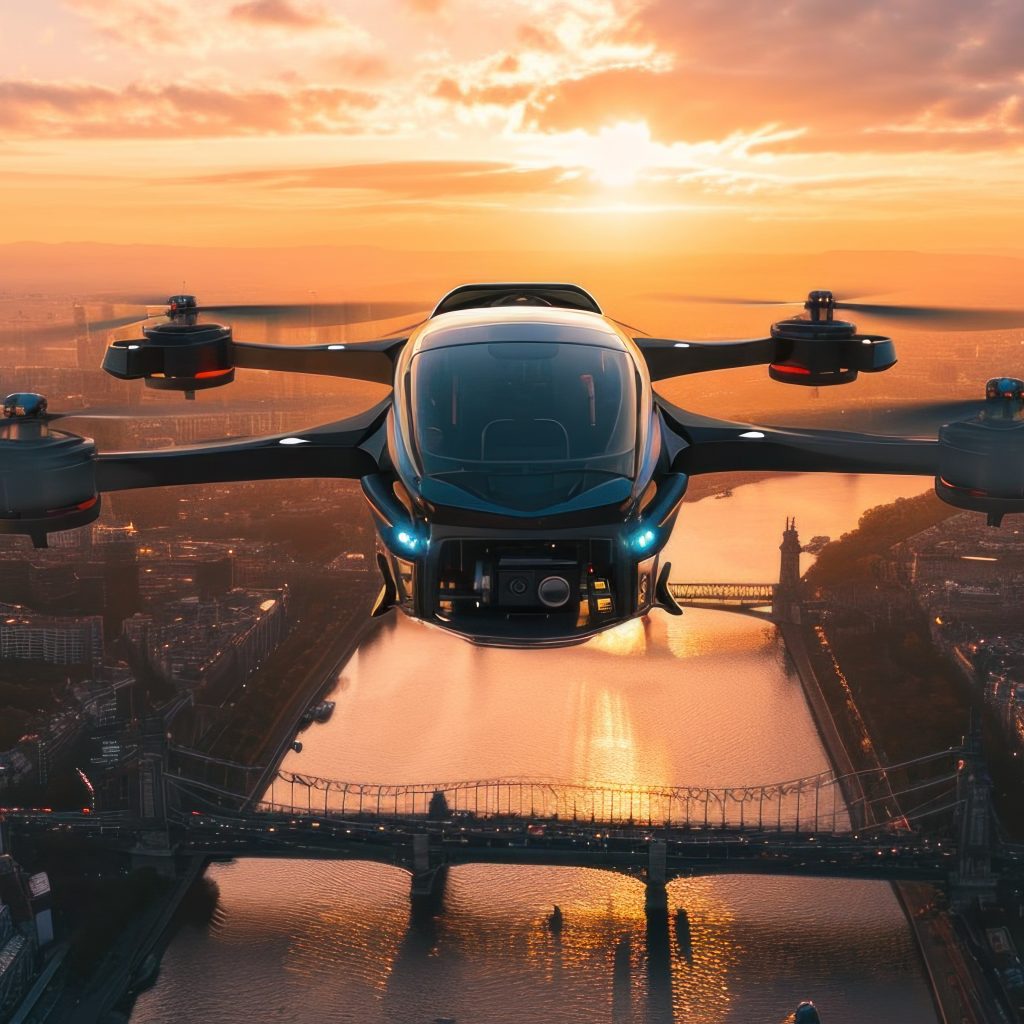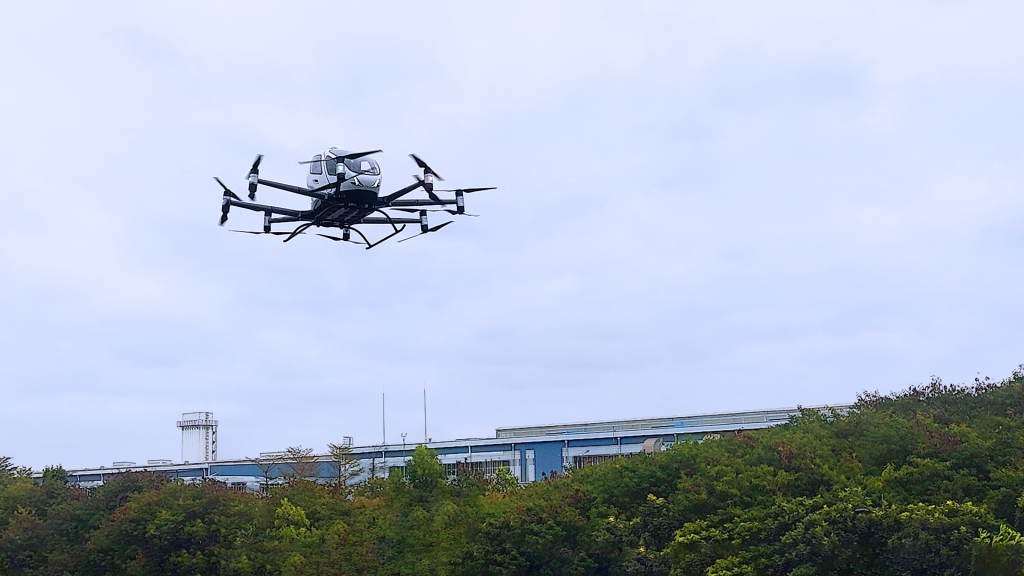On March 27th, the Ministry of Industry and Information Technology, along with three other departments, released a joint statement reigniting discussions about the applications of the low-altitude economy. According to a research report by Debon Securities, airworthiness certification is a prerequisite for the commercial operation of eVTOLs. On April 7th, EHang announced that its EH216-S received the first production certificate issued by the Civil Aviation Administration of China (CAAC). Currently, both EHang and Autoflight have obtained airworthiness certifications for their products from the CAAC.

Credits to Vecteezy
The eVTOL industry is poised for takeoff. According to the “China Low-Altitude Economy Development Report (2024)” by CCID Consulting, the Chinese eVTOL market reached 980 million yuan in 2023 and is expected to grow to 9.5 billion yuan by 2026. Industry professionals, experts, and analysts interviewed by the New Beijing News Shell Finance believe that airworthiness certification in China will accelerate in the coming years, though widespread commercialization remains a distant goal.
Multiple Models Accepted for Certification; Airworthiness Certification Expected to Speed Up
According to CCID Consulting, key players in the eVTOL manufacturing sector include EHang, Autoflight, Zero Gravity, Volant, and XPeng Huitian, among others. Many of these companies have already submitted applications for airworthiness certification. From November 2022 to January 2024, the CAAC accepted type certificate applications for several models, including Volant’s VE25-100 and Autoflight’s E20.

Volant’s VE25-100, credits to Volant
Airworthiness certification generally involves three main types: Type Certificates (TC), Production Certificates (PC), and Airworthiness Certificates (AC). Each certificate has a distinct significance. “The CAAC issues a type certificate when it deems an aircraft meets safety and reliability standards, granting the product market access. The next step involves evaluating the production system. Once production standards are met, a production certificate is issued, paving the way for mass production,” explained Gao Yuanyang, Director of the General Aviation Industry Research Center at Beihang University.
“The most challenging part is the TC review, which is also the core difficulty in eVTOL airworthiness,” said Zeng Tao, Chief Analyst of the Power Equipment and New Energy Industry at CICC Research. “The TC review process is often lengthy, typically taking three to five years. In contrast, the PC and AC reviews are relatively straightforward, usually taking three to six months.”
According to Qin Rui, Director of the Low-Altitude Economy and Low-Altitude Transportation Research Center at China Civil Aviation University, the challenge of eVTOL certification lies in the new technical features, large quantities, and diverse models, which pose new demands and challenges for airworthiness approval. “eVTOL airworthiness certification requires collaboration between the CAAC, industry, and manufacturers to develop new standards,” added Gao Yuanyang.
Currently, only EHang’s EH216-S has obtained all three certificates, securing its ticket for commercial operation. Additionally, Autoflight’s V2000CG has also received its type certificate.

Credits to EHang
Qin Rui noted that the current certifications are only initial airworthiness approvals for individual models, meaning these aircraft can enter the market. Ongoing airworthiness checks will be required to ensure these aircraft remain airworthy over time, involving regular inspections, maintenance, and repairs.
Experts, industry professionals, and analysts believe that the pace of eVTOL airworthiness certification will accelerate in the future. Qin Rui predicts that the number of airworthiness certification applications for eVTOLs in China will increase rapidly from the second half of this year into the next, particularly in the coming years. “This is due to many companies having been in the field for several years, with initial technologies taking shape,” he explained. “Most companies entered the industry between 2018 and 2021, and after years of exploration, various configurations have begun to take form. Companies are eager to obtain airworthiness certificates as soon as possible.”
Companies Continue to Explore Commercialization Paths
On March 27th, the Ministry of Industry and Information Technology and three other departments released the “Implementation Plan for Innovative Applications of General Aviation Equipment (2024-2030),” which calls for the commercial application of new general aviation equipment in urban air transport, logistics, and emergency rescue by 2027.
“The first commercial applications are likely to be in cargo transport, which is relatively low-risk. However, the ultimate goal is more likely passenger transport,” said Qin Rui, explaining that for eVTOLs with a payload of over 100 kilograms, cargo transport might account for only about 15%, while passenger transport could make up around 70%, with the rest used in specific scenarios. He believes that using eVTOLs for commercial cargo transport currently poses no significant issues.
Observations show that companies are taking different technical routes in exploring application scenarios. Among the six models that have received or are applying for type certificates, the ratio of passenger to cargo models is 3:2, with one model being dual-use for both passengers and cargo.
EHang plans to first apply its fully certified EH216-S to tourism. According to He Tianxing, Vice President of EHang, the commercial operation of the EH216-S will begin with low-altitude tourism, starting in cities like Guangzhou, Shenzhen, and Hefei, and then gradually expanding nationwide. Over the past two years, the EH216-S has completed thousands of safe trial flights in low-altitude tourism scenarios.
The report projects that 2024 will see the first wave of commercial eVTOL applications. However, experts believe that widespread commercial operation of eVTOLs may still be five to ten years away, with passenger transport potentially taking two to three years to realize.
Commercializing eVTOLs is a comprehensive process. According to Gao Yuanyang, the maturity of airworthiness certification, urban airspace and route management, public acceptance, aircraft technology, and future urban air traffic management are all critical factors for large-scale commercial use.
High Costs and the Quest for “Universal” Aircraft
What factors might limit the commercial progress of eVTOLs? Qin Rui points to the issues of cost and pricing. The cost per flight is high. According to a white paper jointly published by Southern Airlines General Aviation and Volant, a one-way trip from Shanghai Lingang to Hongqiao Transport Hub would cost 1,188 yuan, with each seat priced at 297 yuan, assuming a 10% operating profit margin in the initial phase.
The market price of an entire eVTOL, such as EHang’s EH216-S, is 2.39 million yuan per unit in China and $410,000 internationally. As of 2023, EHang has delivered over 200 units of the EH216-S.
“eVTOL is a technology-driven industry,” says Qin Rui. Developing versatile aircraft that can easily switch between different scenarios can help distribute costs. “Many current configurations have limited application scenarios, essentially making them custom solutions, which are inevitably expensive and produced in small quantities,” he predicts that only a few classic aircraft will remain in the future.
Current investment trends in China show a preference for tilt-rotor and multi-rotor configurations. The report indicates that most investment events in the Chinese eVTOL sector in 2023 focused on tilt-rotor configurations. Among disclosed funding amounts, companies developing multi-rotor technologies received the most investment.
Qin Rui also notes that while the construction of takeoff and landing sites and low-altitude airspace infrastructure might have a limited impact in the early stages of eVTOL development, it will become crucial as large-scale deployment and high-density operations begin. He suggests that the eVTOL sector should proactively plan for infrastructure, ensuring land and airspace are used efficiently and integrated with existing facilities to avoid wastage.
“eVTOL infrastructure requires public funding and should be treated as public infrastructure,” he asserts, adding that infrastructure for communication, navigation, surveillance, and meteorology should also be government-funded and open to numerous low-altitude users. “While some fees could be charged, leaving it entirely to private initiatives is not advisable due to its public nature.”
Debon Securities’ research shows that the current infrastructure for the low-altitude economy mainly comprises general airports. According to the General Airport Information Platform, as of January 10th, China had 105 certified general airports and 348 registered general airports.
The Industrial Ripple Effect of Mature eVTOL Commercialization
What industrial benefits might mature eVTOL commercialization bring? “As infrastructure rolls out, it will not only benefit upstream planning, design, construction, and materials suppliers but also accelerate the large-scale deployment of eVTOLs,” says Qin Rui. His research estimates that every 1 yuan invested in an eVTOL can generate 7 yuan in value for related industries.
Beyond its immediate industrial chain, eVTOLs will also interact with other future industries. Gao Yuanyang believes that eVTOLs will integrate traditional general aviation products with cutting-edge fields like artificial intelligence, new energy, and air-ground connectivity, fostering mutual growth.
“Intelligent and connected systems are crucial for the large-scale deployment of eVTOLs,” says Qin Rui. Micro-scale weather observation and forecasting are challenging, and the operating environment is complex. “Using integrated sensing and computing technology can enhance the aircraft’s ability to autonomously identify risks and proactively avoid them, simplifying many issues.”
Leave a Reply